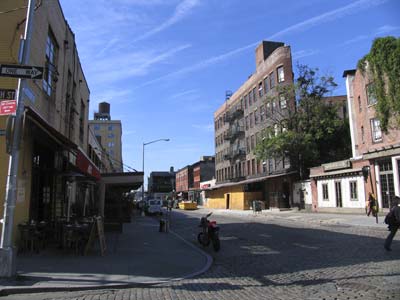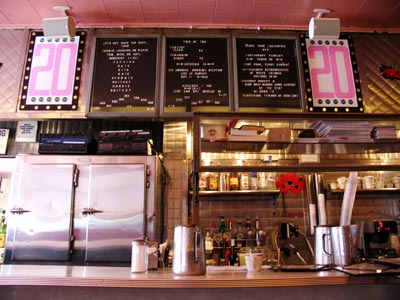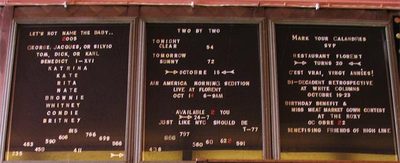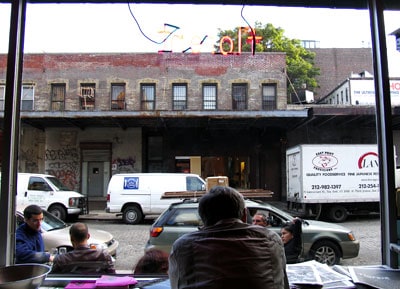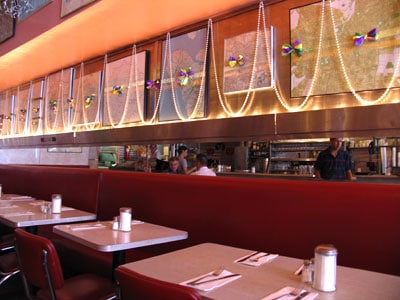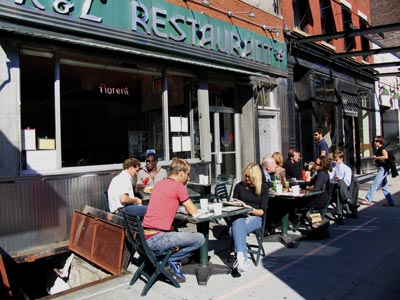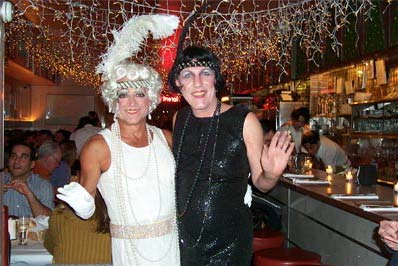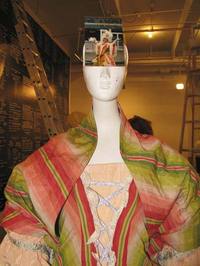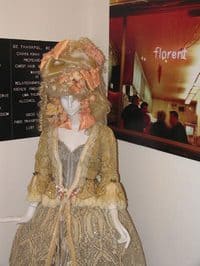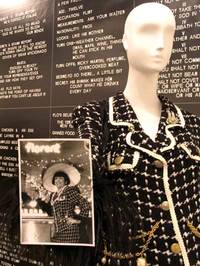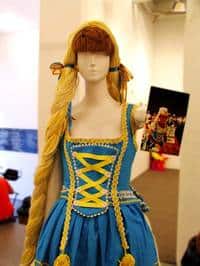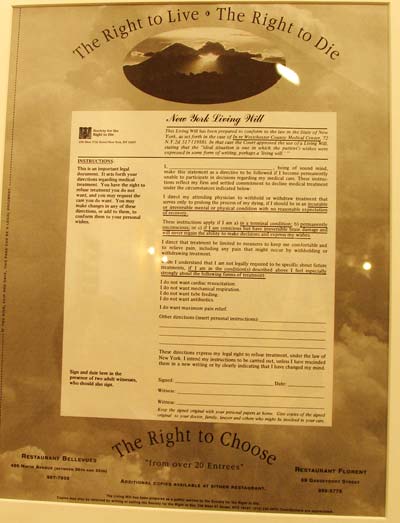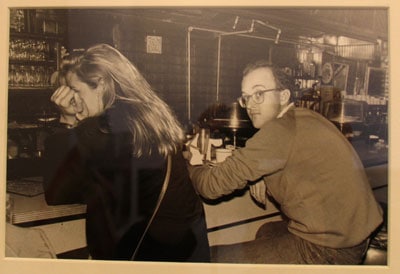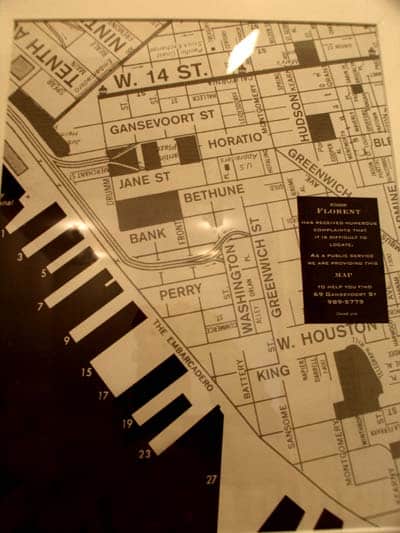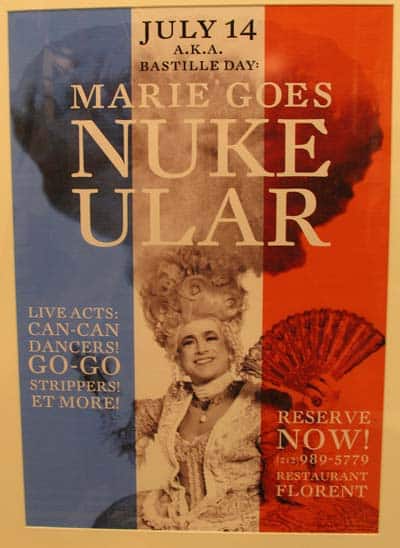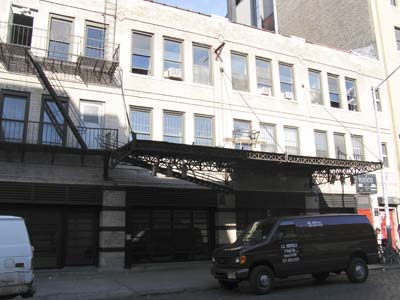I had a visit earlier this week with Florent Morellet. The man and Florent, the restaurant he created, are both being honored on Saturday at the Roxy nightclub in a benefit for the High Line, the sinuous elevated track which runs through downtown. The High Line is in the process of being turned into New York's most exciting public space in years. I've talked about it here before.
It's a cause I feel strongly about, so I'm happy to be able to share with you some of Florent's story and a visual taste of the meatpacking district's legendary late-night eatery. For those New Yorkers who haven't visited Florent, this may provide the inspiration. For those out of towners looking for a great New York meal, this is the place to have a delicious one, and boy does the place have a history…
This weekend rumors are swirling about a special appearance at the Roxy by a performer who first made her mark in New York City twenty years ago. I hear there is truth to those rumors about a late night appearance. But something just as entertaining, and more profoundly New York is going to be happening at the Roxy earlier that evening, and it's a tribute to someone whose imprint on Manhattan's nightlife runs deep, a celebration at which food, drink, raucous revelry, drag queens, performers, and celebrity will be plentiful.
Here's a helpful hint: If you really want to be sure to get into the (hush, hush) guest appearance at the Roxy later that night, double your fun and get a ticket to the benefit [more details at the bottom of this post]. You'll be able to purchase the bracelet that will assure you entrance into the club when it reopens at 12.
Florent Morellet made his mark on New York's downtown in the early 80's when he opened a small bistro called “Florent” in a classic American diner space in the city's meatpacking district. The old restaurant's sign still remains. The “specials” board he stands beside (above), which is one of dozens that have appeared in the bistro over the years, says a lot about whom you might find at the restaurant on any given night.
Florent opened Florent in 1985, taking over a diner space in the city's then meatpacking district. In 2000 he was instrumental in starting the campaign to have the pleasantly grimy neighborhood with its trucks and warehouses and stench of meat juices recognized as a historic district.
Many changes had come to the area in the five years since he moved in, but it took the construction of the enormous Hotel Gansevoort nearby in 2003 to get other residents motivated to take action, and soon they received landmark recognition for the Gansevoort Historic District. Florent, along with preservationist Jo Hamilton, lead the charge.
Florent's love of urban planning and daring architecture were sometimes in cahoots and sometimes at odds with changes in the neighborhood. He's a huge fan of skyscrapers, as the New York Times noted this week in a colorful piece, but to save the neighborhood he actually thwarted the development of a skyscraper (by another Frenchman, Jean Nouvel) that was to be built just blocks from the restaurant, somewhat to his architecture-loving chagrin.
Yet Florent, in its twenty years, has remained a steadfast beacon of pink neon on rutted, cobblestoned Gansevoort Street, thick with the smell of raw meat from the packing plants that still operate there.
Over the years Florent has inspired a legion of activists to join him in support of causes from the Pro-Choice movement to the Right to Die movement, took part in his own way after 9/11 with an antique fireboat he had helped save from destruction, and singlehandedly made Bastille Day a holiday that downtown New Yorkers have come to celebrate as their own, in only the way that Florent can do. That is, with lots of feathers.
Earlier this week I spent the afternoon with Florent and hope to share with you some of the reasons why he is being honored with a benefit this weekend, sure to be as colorful as any in New York's recent memory. The restaurant is at the heart of his activism, and serves as a sort of culinary control room for his activities:
Florent appears much like any other diner, until you begin noticing small details like the fact that the menu items aren't low-end diner items but bistro choices like goat cheese salad and steak frites.
The current food “specials” board (click below to expand) isn't what you'd expect either. It contains a weather report, a list on what not to name the baby this year, and an ad for this weekend's Bi-Decade{nt} Ball at the Roxy. It's constantly changing with the help of a writer, Tom Eubanks, who has worked with Florent for years. He also edits an online “literary” zine for the restaurant called Papotage.
Sit in one of these stools and your tush will share have shared a space with Michael Stipe, Liza Minnelli, Martha Stewart, Tom Cruise, David Hockney, Philip Johnson, Graham Norton, Richard Gere, Tobey Maguire, Sylvester, Keith Haring, Cher, Philippe Starck, or any one of hundreds of celebrities that have frequented Florent and still do.
Florent at work in the front window:
The only physical change Florent made to the place when he moved in was the French-inspired addition of a banquette and a wraparound mirror “so people facing the wall could see the rest of the room and not feel like they [are] in purgatory.”
He also added rows of colorful maps, an obsession he brought with him from his years as an urban planner. Right now the maps are draped in Mardi Gras beads as the theme for this year's upcoming Halloween soiree is “Mardi Gras: Hell or High Water.” At Florent, the events of the day however political or frivolous are put front and center. Resilience is celebrated, as is humanity.
When Bastille Day rolls around, the drag comes out of the closet and you better believe the place is packed.
That's Florent on the left. You'll find him in drag for the “high holidays”: Bastille Day, Halloween, and New Year's Eve.
Part of the celebration of the restaurant's 20th anniversary this week is the opening of an exhibit at the White Columns Gallery (Horatio St. at West 4th) showing off a retrospective of the restaurant's colorful past, including a look at Florent fashion over the years:
Nothing like a restaurant with its own costume archive! Yet behind the fun there has always been an eye on the more serious issues of the day. Florent's advertisements consistently reveal an inspired activist with an eye for design. For many of his early ads he collaborated with a well-known graphic designer named Tibor Kalman.
He met Tibor through a man he dated in '85 named Larry Rosenberg, who urged Florent to work with him. When Larry became very sick in '86 and died of AIDS in '87, it inspired Florent and Tibor to create an advertisement in his honor that Florent sees as a watershed moment.
The ad appeared as New York's gay population was experiencing a brutal thinning at the hands of the devastating disease, and features a living will as its centerpiece.
Says Florent: “Larry's death was very hard. He was in denial, and, as was often in a situation like that, he got abused by the medical establishment. They were doing futile, aggressive treatments days before he died and the nurses were unreceptive to his pain. They were coming late and when he was complaining they were telling him he should be a man. After his death, Tibor and I decided to do this ad for Paper magazine advocating the Right to Die issue, and we asked The Society for the Right to Die if we could use one of their living wills for an ad. They agreed on the condition that they would proof the ad before publication. Tibor was a big bully and published the ad without their agreeing.”
The ad:
“Shortly after the publication I got a call from the organization's executive director who was not a happy camper. She had several complaints from board members about the ad. I tried to explain to her and said come to my restaurant. Let's do lunch, and I said, you know, I have AIDS, my boyfriend has AIDS. Everyone around me has AIDS. People are dying left and right. There is a whole constituency that you need to reach out to — the only way you can reaach them is with a sense of humor. She got it 20/20. A couple months later she called and extended an invite to be on the board.”
He spent 10 years on that board and in '97 with a few other people started Compassion in Dying, which advocates aid in dying. In '03 he became a National Board Member and in '04 they merged with End of Life Choices (which used to be the Hemlock Society).
A sense of humor is front and center on many of the restaurant's other ads, political or not.
Last year, Spencer Tunick, the artist that has grown famous around the world for his massive photographic installations of naked bodies in public places, shot a cover for Poz magazine in which he packed Florent with naked people with HIV. Courageous to be sure, but when you realize that the menu boards, along with their activist messages and weather report contain a running graph of Florent's T-cell count, this kind of bold statement seems par for the course.
Florent himself appears in the photo. These photos are up at the White Columns exhibit, along with a sampling of other photos from Florent's past.
The artist Keith Haring:
Lady Miss Kier of Deee-Lite holding a “no-hangers” cookie Florent had baked to give to those who were riding down on buses he had organized to go to Washington DC for a pro-choice rally:
James Earl Jones:
Also on display at the exhibit are Florent's maps — not the ones he's collected of various cities over the years, but maps he's created himself, fantastical cartography that takes familiar urban settings like Paris and extrapolates on the landscape using a keen sense of design and his own knowledge of urban planning. He's created a whole series of cities that never existed and never will, enchanting to imagine and gorgeous to look at…
That's perhaps why so many find their way to Florent, pulled in by the strange yet coherent fabric of patrons, design, and great food. This map he created for an ad at first glance looks like a map showing the location of the restaurant. But wait, is it San Francisco or New York?
Strangely enough, it's both. Florent combined elements of the Embarcadero district of SF with the meatpacking district to create a confusing riddle that is characteristic of the social and geographic gumbo that pervades Florent's imagination.
Florent moved to the U.S. in 1978, though his parents had brought him on a tour of the country in 1967.
He studied urban planning in London in the early 70's and then took a year off and embarked on a hitchhiking trip across the U.S. with a friend. He “found a gay paradise” in San Francisco and a job in a restaurant on Polk Street.
When he moved back to France he opened a restaurant in Paris with an American and his brother. “It was a great social success and a financial disaster. A horrible experience,” he says. “That's where I really learned the tools of the trade. In Paris I learned about humility, one of the most important lessons you can learn. Every decade one should have a good shot of humility.”
Properly humbled, he decided to move back to the U.S. “When I left Paris I was over France. I hadn't spent much time in New York but I knew it was the place. I had told my friend to do anything to stop me if I mentioned the word ‘restaurant'.”
Well, we know now his friend wasn't very successful:
Florent has seen much come and go in the Meatpacking District since he opened the restaurant in '85. The benefit this Saturday night at the Roxy is not only a celebration of his restaurant's 20th Anniversary, but it's also a benefit for the most important new public space in Manhattan, the High Line, a serpentine park that's being developed atop an abandoned elevated train track that runs throughout the district.
It's just one more sign of change for this area which used to be home to some of the city's grittiest gay nightlife. For nostalgia's sake, Florent and I took a walk adjacent to the High Line, and he pointed out what's become of some of those dirty watering holes. Here's a sample for those of you old enough to remember:
The most recently vanished bar was Hell, just down the street from Florent, soon to become another restaurant:
Here's the site of the old Mineshaft: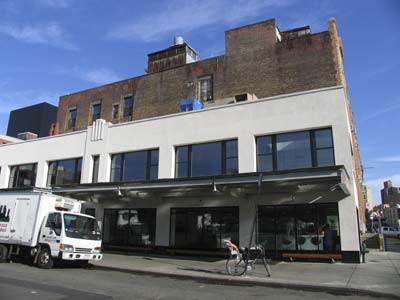
Afterhour dark room activity used to abound at Jay's, now the restaurant Vento:
Jackie 60, now a Scoop boutique:
And where the multi-tiered Mars nightclub used to be, a parking lot: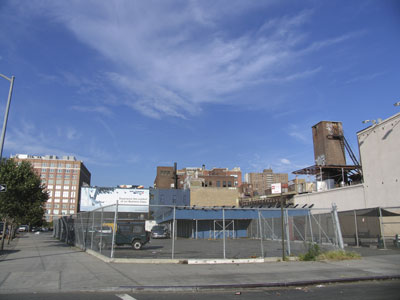
We end up at the upscale boutique Jeffrey, where we find they've installed a mini-Florent in the store's entryway:
Florent immediately feels right at home. The businesses in the meatpacking district understand and appreciate what he has done for the neighborhood. Buildings that used to house the seedier nightclubs of New York's gay past are now home to boutiques and upscale restaurants. Florent realizes there's little he can do, despite his interests in preservation, to abate the changes that real estate prices and economic cycles will have on a place, so he instead chooses to embrace it.
Says Florent: “When I came in '85 I'm sure there were people complaining that I took this diner and gentrified it. It had a clientele,” he explained to me. “I could have chosen to cry each time [something changes in the neighborhood] but I go on. If you come from a small town in the dreary west of France to New York City you have to enjoy change, especially if we are talking about Manhattan.”
With all luck, the bistro at 69 Gansevoort Street won't be changing anytime soon.
More information on the Florent Bi-Decade{nt} Ball from 7-11 at the Roxy this Saturday. Guests at the Florent/High Line Ball can purchase $25 wristbands for the special event at the Roxy during the Florent/High Line Ball without waiting in line outside.
And more information on the High Line, which it benefits.
Hopefully, we'll see you there.
And to see more memorabilia visit the Florent retrospective at the White Columns Gallery through October 23rd.



